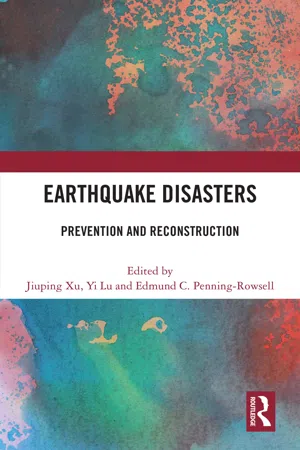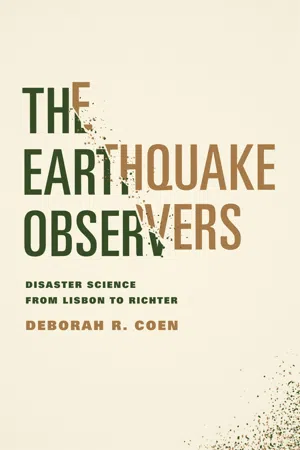Earthquakes
Earthquakes are natural phenomena characterized by the sudden release of energy in the Earth's crust, resulting in seismic waves. They can cause destruction and loss of life, and are often associated with tectonic plate boundaries. The magnitude of an earthquake is measured on the Richter scale, with larger magnitudes indicating more powerful seismic activity.
5 Key excerpts on "Earthquakes"
- eBook - ePub
Lees' Process Safety Essentials
Hazard Identification, Assessment and Control
- Sam Mannan(Author)
- 2013(Publication Date)
- Butterworth-Heinemann(Publisher)
...Earthquakes are a geographical phenomenon and hence in many cases the original correlations have been derived for a specific region, often California. This should be borne in mind in respect of the relationships quoted. The relation of focus and epicenter, magnitude and magnitude scales, wave energy and the surface wave magnitude, frequency and return period, intensity and intensity scales are demonstrated in the full version Lees’ book (fourth edition). 28.3 Earthquake Effects The effects of an earthquake may be classified as direct or indirect. The direct effects include the following: 1. ground shaking; 2. ground lateral displacement; 3. ground up-lift and subsidence and the indirect effects; 4. ground settlement; 5. soil liquefaction; 6. slope failure: a. avalanches, landslides, b. mud slides; 7. floods; 8. tsunamis and seiches; 9. fires. Of the direct effects, ground shaking usually occurs over a wide area. At faults, fault displacement results in lateral movement of the ground and surface breaks. The distance over which the surface breaks occur is variable. There may be tectonic up-lift and subsidence. Of the indirect effects, ground settlement may occur due to compaction of unconsolidated deposits. There may be soil liquefaction, giving a ‘quick condition’ failure. Slope failures may occur in the form of avalanches, landslides, and mud slides. 28.4 Earthquake Incidents Tabulations of Earthquakes are given in a number of texts. Eiby (1980) gives a chronological list; this includes the values of the magnitudes...
- eBook - ePub
Earthquake Disasters
Prevention and Reconstruction
- Jiuping Xu, Yi Lu, Edmund C. Penning-Rowsell, Jiuping Xu, Yi Lu, Edmund C. Penning-Rowsell(Authors)
- 2021(Publication Date)
- Routledge(Publisher)
...An attempt has thus been made to link good earthquake science and people’s participation in practising accurate perceptions and sensible responses. A number of geological theories for earthquake occurrence and the role of various scientific communities, policy makers, practitioners and end-users have been considered in preparing this paper, using a wide range of published materials. The geological background to earthquake occurrence 2 From earliest antiquity the cause of Earthquakes has been associated with the idea of internal stress build-up inside the earth. This stress build-up is now associated with plates’ interactions. The first systematic and non-mystical treatment of Earthquakes came from Greece, where its people experienced Aegean volcanoes and Earthquakes accompanied by ‘tidal’ waves (tsunamis). A number of Greek philosophers offered mechanical explanations for these natural events. Strabo, for example, noted that Earthquakes occurred more frequently along coasts than inland. He, like Aristotle, suggested that Earthquakes were caused by rushing subterranean winds, igniting combustible materials underground. In reality, these ‘rushing subterranean winds’ are the propagation of elastic waves through the earth’s materials, while, the ‘ignition of combustible materials’ is the explosion or the release of accumulated strain due to various stress fields in those materials. We now understand that although earthquake events are intrinsically related to plate-tectonic activities, they are rare in the plate interior. However, often destructive Earthquakes have occurred in the continental blocks of China, India, Iran and Turkey. These Earthquakes are popularly known as ‘ continental Earthquakes’...
- eBook - ePub
The Earthquake Observers
Disaster Science from Lisbon to Richter
- Deborah R. Coen(Author)
- 2012(Publication Date)
- University of Chicago Press(Publisher)
...F IVE Geographies of Hazard Among the first desires which seize a visitor in an earthquake country, is to experience a shaking. —John Milne 1 Nineteenth-century Europeans had a tendency to think of Earthquakes as a “tropical” phenomenon, characteristic of savage realms, where nature was said to operate on a grander scale. 2 When the “scientific” historian Henry Thomas Buckle set out to explain England’s rise to the pinnacle of civilization, he divided the influences of nature into two classes: those conditions that appealed to rational understanding, and those that instead provoked the “imagination.” Foremost among the latter were Earthquakes and volcanoes, which thwarted every impulse to deduce the laws of nature: Of those physical events which increase the insecurity of Man, Earthquakes are certainly among the most striking, in regard to the loss of life which they cause, as also in regard to their sudden and unexpected occurrence. . .. The terror which they inspire, excites the imagination even to a painful extent, and, overbalancing the judgment, predisposes men to superstitious fancies. And what is highly curious, is, that repetition, so far from blunting such feelings, strengthens them. . . . The mind is thus constantly thrown into a timid and anxious state; and men witnessing the most serious dangers, which they can neither avoid nor understand, become impressed with a conviction of their own inability, and of the poverty of their own resources. In exactly the same proportion, the imagination is aroused, and a belief in supernatural interference actively encouraged...
- eBook - ePub
- Mark Harris(Author)
- 2017(Publication Date)
- Routledge(Publisher)
...Chapter 10 Geography in the news One of the major attractions of studying geography is the fact that it is always current, ever changing and related to our lives. That is why it is so important to reflect this in our lessons. When tragic natural disasters happen such as an earthquake this is an opportunity to enhance the students’ understanding of the world around them, linking their learning to real-life situations and scenarios. Only through education and study can we ever hope to fully understand the processes that create such events and through this understanding we can aim to put in place strategies and procedures to help mitigate against such hazards. Obviously not all geography in the news is linked to a natural disaster yet volcanic eruption, Earthquakes, flooding, tropical storms, wildfires, drought and extreme weather events are all unfortunately commonplace throughout the year. Thus we should take every opportunity to educate our students about the world around them and current affairs. Geography in the news can serve to meet a number of aims of the geography we teach in the classroom...
- eBook - ePub
The Fukushima and Tohoku Disaster
A Review of the Five-Year Reconstruction Efforts
- (Author)
- 2017(Publication Date)
- Butterworth-Heinemann(Publisher)
...One such example is reinforcement or replacement of inadequate buildings or structures, such as wooden housing. Immediate spread of these counteractions will have a great effect in disaster prevention. On the other hand, the science of Earthquakes still has many unknowns. In the 1960s, with the rise of space exploration, Project Mohole was dreamed up to drill a hole through the earth to reach the mantle; however, it still has not yet reached the mantle. In the field of space exploration the interplanetary space probe New Horizon reached Pluto, but in our studies of the earth to discover where Earthquakes originate, we have not made great advances. In terms of the mechanisms of how Earthquakes occur, the phenomena have not yet been clarified. There will always be events that go over our heads, as we take measures based on the stack of knowledge we have gained so far. When the next major earthquake hits, our efforts to collect as much continuous monitoring data before the breakout as possible and to pass the data to our next generation will surely prove useful for disaster prevention in the future. The knowledge we have now about Earthquakes and that we take for granted came about through detailed analyses of earthquake waves after the 1960s, which is very recent. As earthquake wave analysis advanced, seismologists restudied past Earthquakes that took place decades ago and piled up evidence on which to base much of what we now know. For disaster prevention in the future, we shall keep “records of raw data” without the filter of our contemporary sense of value. We have to reach our conclusions with the best analysis available at the time, but at the same time pass the “records of raw data” to the future. That data may contain important signals that we cannot detect with our current technology and knowledge. References [1] Uyeda S., Kanamori H. Back-arc opening and the mode of subduction. J. Geophys. Res. 1979;84(B3):1049–12061. [2] Ide S., Baltay A., Beroza G.C...




